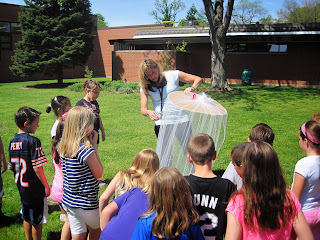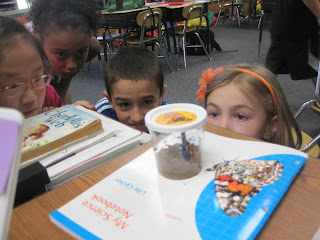We "fished" for 30 seconds at a time. The rules were: no touching fish with your hands, one fish per pole a a time, and if a fish drops before landing in your boat, it has to go back into the ocean.
They fished for 4 years, or 4 30 second cycles. At the end of each cycle, I came around to "re-populate" their oceans. The children grouped their fish for me by color. For every two that remained of each color, I gave them one more fish.
During our first rounds. the children's self-appointed goal was to get as many fish as they could. I've never seen plastic spoons move so fast! They quickly realized that their oceans were completely out of fish.
We talked about why this happened. The children realized that they took too many fish, causing them to become extinct. We talked about how commercial fishermen may take more fish from the ocean than what they really need in order to make more money. This causes the food chain to become negatively impacted.
We connected this activity to our natural resources (water, trees, energy). The children were able to recognize that if we use more than what we need, the resources will simply run out. If we use only what we need, are careful not to pollute, and are mindful of animals who are already endangered, our resources will be conserved, and natural elements will be better able to naturally replenish.
The children were ready to go fishing again. This time, they fished much differently.
I heard phrases such as "Slow down! You are taking too many fish!" And "If you take that red fish, it won't re-populate! Don't take any more red!"
One student said, "I don't want to fish this round, Miss O." Other groups put down their fishing poles before the time was even up, leaving plenty of fish in the ocean and only a few in their boats. They waited with their arms crossed until the timer ran out. They noticed that soon their oceans were FULL of fish!
Mission accomplished! The children did an AMAZING job learning about conservation during this activity! Proud teacher moment!! Way to go, class!









































